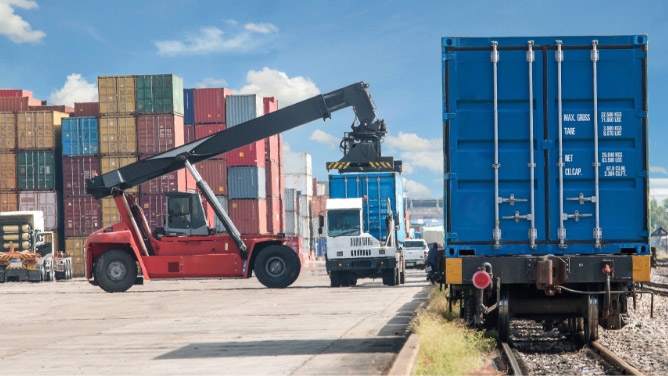
What is dispatch software?
Dispatch software helps businesses that operate vehicle fleets to schedule and monitor what their vehicles and drivers are up to at any given moment. Dispatch software is used to schedule deliveries, create efficient delivery routes, assign drivers, assign vehicles and track them on the road, keep customers informed, handle work orders and billing, communicate with the field, and collect and analyze data that can be used to improve operations, among other tasks.
Dispatch software generally provides a centralized dashboard that gives the dispatcher easy access to all necessary information and data. Mobile devices on the vehicle or carried by the driver keep the field connected to the dispatcher. Well-designed dispatch software should be able to integrate fairly easily into other standard business systems, such as CRM (customer relationship management), ERP (enterprise resource planning), accounting, inventory, etc.
Why do you need dispatching software?
Nearly any business or industry that operates a fleet, even a small fleet, will benefit from a capable dispatch system. Construction, transportation, repair services, shipping companies, home health, emergency medicine, and more all have a need to control costs, meet promised schedules, use resources efficiently, and track their fleets. In all those tasks and more, dispatch software is an indispensable tool in an era of ever-rising expectations for speedy arrivals and constant updates.
Without dispatch software to help, there are many things that would have to be done manually, which is not only time-consuming, but for certain tasks, such as creating the most efficient delivery routes for multiple vehicles making multiple deliveries, would be virtually impossible.
Benefits of dispatch software for fleet operators

A capable dispatch software system benefits fleets in numerous ways. On-time service and readily available information build customer satisfaction and loyalty. Efficient routing reduces wasted fuel, driver hours, and wear and tear on vehicles. Simply, dispatch software can keep fleets operating at peak efficiency and thus support more effective, profitable business operations.
Optimize routes and automate schedules
Automated scheduling has become an absolute necessity in today’s market of ultra-high expectations, with thousands of orders a day from online customers who want to know when their order will arrive, and not just the day but the hour. An automated, cloud-based scheduling system that uses artificial intelligence, machine learning, and complex algorithms to integrate orders, inventory, box size, vehicles, and driver scheduling will make it possible. With intelligent scheduling, dispatchers get alerts on loads that should be batched together based on delivery windows and locations, customers can request specific delivery times, and carriers can fulfill them.
The same technology is applied to routing. Even a small fleet, say five vehicles with ten stops each, can mean thousands of routing possibilities. With automated route optimization, fleets can set parameters that prioritize speed, shortest route, or high-priority customers based on their specific business needs. Using dispatch software to optimize routes not only reduces miles driven, fuel use, and driver hours, but it also substantially cuts the amount of time dispatchers must spend on routing.
Connect to customers and the field
Dispatch software also provides essential communication tools so that drivers in the field can send and receive information from the dispatcher, and customers can stay in touch with their delivery.
One way the dispatch software can greatly improve customer satisfaction is by providing them with easy access to all relevant information about their order. They can see if it’s shipped, from where and when, and the expected delivery window with a few clicks. The system can also send them texts and emails with updates, reducing all those “What’s Going On?” phone calls to customer service.
A robust dispatch platform will include dedicated apps or mobile devices that keep drivers on the road in touch with the office. Devices with GPS tracking can provide real-time speed and location information. Changes to the schedule or weather and traffic alerts can be delivered to the driver, who can also communicate questions or problems back to the office. More sophisticated on-board computers can handle even more complex communication. (It should be noted that drivers must use these devices in a safe and legally compliant manner when driving.)
Advanced preparation
The last thing a customer ever wants to hear from a repair tech is, “Sorry, but I didn’t bring that part with me, I have to come back tomorrow.” In fact, field personnel should never be sent to a job without knowing the history of the job, what to expect, and what equipment, supplies, or products they’ll need. With an effective dispatch system, they’ll have full information and be able to prepare for a trip in advance, get the job done in one visit, and keep the customer happy.
Track metrics and revenue
One of the most important products of dispatch software is data. The data that a dispatch system generates can tell a fleet manager where money is being made, where it’s being lost, and where it’s being wasted. Efficiency metrics may include idling time, miles per stop, or quantity per mile. Financial metrics cover cost per stop, per mile, and per quantity delivered. Other metrics can quantify customer service and overall fleet productivity.
Improve the customer experience
Some dispatch software can also be integrated with a business’s call center, where sales or scheduling staff take calls, get information, and set appointments. The system will prompt the customer to the right destination. It can also record the calls to create an accurate business record of what was said, as well as for training to improve staff and driver performance.
If a technician is being dispatched, the system can be set up to provide ongoing communication to customers to let them know when someone is on the way and when they will arrive. Appointment reminders, changes, and opportunities to provide feedback all contribute to an improved customer experience.
Improve efficiency and fuel consumption
We’ve all heard that whatever goes up must come down, except, of course, for fuel prices, something fleet managers know all too well. It’s been estimated that fuel costs account for 20 – 40% of operating expenses. So clearly, any improvement in the efficient use of the fleet will have an impact on fuel used, which impacts overall expenses, which impacts margins. Dispatch software raises efficiency and reduces fuel consumption in a number of ways.
Route optimization may be the most impactful. Simply put, if a fleet can make more stops in fewer miles, it will use less fuel (and driver time) to do so. The system can also help ensure that vehicle capacity is being fully utilized so fewer trips can be taken.
With real-time data and updates, dispatch software for trucking can keep drivers from getting stuck in fuel-wasting traffic or weather situations. The dispatcher can alert the driver to changes so that miles are not wasted. And as mentioned earlier, if a driver is fully prepared for whatever situation they’re sent into, there will be fewer trips involved.
Maintain compliance
Regulatory compliance is a constant issue for fleet owners and drivers alike, with state and national requirements that need to be met and documented. Dispatch software can help fleets and drivers remain compliant with HOS (hours of service) regulations and create a verifiable record as drivers report their hours electronically. The system should be able to automatically create a variety of required or helpful records that can be easily accessed and provided to agencies as needed.

5 Considerations when choosing the best dispatch software for fleets
There are a number of vendors today that provide dispatch software of varying quality, capability, and price. These are some of the major factors to consider as you decide which solutions will work best for your fleet.
1. Scalability
As businesses change and grow, they want a scalable, adaptable system that not only grows with the business but also drives business growth. After all, growth is one of the reasons to deploy a capable dispatch platform in the first place.
A cloud-based system will scale up automatically as the demand for server capacity increases. A modular software architecture or design will allow new features and modules to be added as needed without impacting the overall system.
2. Integration with other systems
Look for a system with excellent integration and automation capabilities so it can work seamlessly with other systems, such as your enterprise resource planning, customer relationship management tools, or inventory systems. It should be able to integrate with third-party tools like GPS and comms tools and provide APIs so you can develop add-ons or integrations as needed. Strong data and resource management capabilities will also support scalability as your needs for a more robust system grow.
3. User-friendly interface
Getting people to accept, use, and fully embrace a new software platform is always a challenge, but if they don’t, neither they nor the organization will enjoy its full benefits. So, an unfriendly or hard-to-navigate interface that makes people even more reluctant is the last thing you want. A proper interface, on the other hand, will be designed with the end-user in mind, not just the enterprise. A user-friendly interface that’s attractive and intuitive, helpfully supporting and guiding the user as they learn the system, will encourage adoption. Data and graphics that make things easy to see and interpret will help users see the value of the system. And instead of being a roadblock, the interface will draw users in.
4. Mobile accessibility
When you have personnel on the move, you need access to them, and they may need access to any number of things, including customer information that they need for success on an assignment. So when looking at various systems, take note of their ability to keep your driver connected to the office and its systems and to keep the office connected to the driver and their activities.
5. Pricing
Price is a consideration in any system purchase, but it’s generally a mistake to elevate price over value, function, and performance. A cheaper system that isn’t up to the task may end up costing money without saving any. A poorly designed system can frustrate both users and managers as adoption is slow and difficult.
A more robust system may cost more, but it will pay for itself in reduced operating costs, significant time savings, and improved customer satisfaction. Of course, a higher price does not always indicate a better product, so whatever decision you make, investigate thoroughly beforehand.
How specific industries benefit from dispatch software

3PLs (third-party logistics) and parcel delivery
Customer expectations for I-need-it-today-or-forget-about-it package delivery are already set and not changing soon. So parcel services and 3PLs can longer afford to be as efficient as humanly possible. They need to go beyond and put artificial intelligence, machine learning, and the cloud on the job in the form of an effective dispatch system.

Food and beverage
Food and beverage services can improve on-time deliveries by using dynamic routing to get items to the customers as promised. This will also reduce refusals for items delivered late because they won’t be late.

Wholesale distribution
Wholesale distributors can use hybrid or dynamic routing to meet customer expectations for on-time service, reduce refusals, and lower miles driven and fuel used.

Retail distribution
Provide stellar customer service with up-to-date information on shipments and exceptions. Impress customers by accommodating last-minute orders and providing opportunities for feedback.

Industrial
Minimize fleet costs with logical route planning. Maximize customer satisfaction with on-time deliveries.
How to implement dispatch software

Implementation can be the trickiest part of any new software platform. Companies that attempt to configure a new system on their own can sometimes make mistakes at the beginning that are difficult to change later or prevent users and the organization from getting all the benefits they should. It’s strongly recommended that you work closely with the vendor or expert consultants to ensure your system is installed and configured so it works as intended and delivers the full value you expect.
Training
If you want your organization to fully embrace and leverage the new system, a robust training plan is essential. The vendor should be able to assist, as well as internal training resources. Make sure training is taken by anyone using the system, or they will find it intimidating and be slow to adopt.

The future of dispatch software and the holistic approach
A holistic approach to dispatch software implies that, in the future, fewer individual tools will be needed to handle dispatching; functions will continue to be consolidated into a single platform or solution.
A single platform will cover not just dispatching but full telematics, driver safety, and more. This will be a great advantage, especially in fields like emergency response, where time is of the essence, and fewer separate applications mean a more streamlined approach without cross-platform issues. Artificial intelligence and machine learning will play larger roles, as will the Internet of Things (IoT), as vehicles themselves become smarter and more capable. In the dispatch software of the future, everything will be connected, and any number of activities like compliance, reporting, security, and analytics will be easier, if not completely automatic.
Stay on top of what’s new

New cloud-based solutions and technology advances like artificial intelligence and machine learning mean ever-greater possibilities for dispatch software and platforms that can have a major impact on efficiency, fuel consumption, safety, and the fleet’s bottom line.
Contact the dispatch optimization experts at Omnitracs today to learn about our latest innovations for fleet performance.